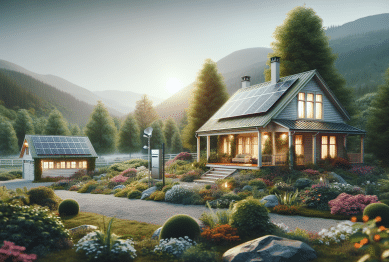Curious about smart home technology and how it could change everyday life? Dive into this actionable, reader-friendly guide exploring how smart thermostats, home security systems, automated lighting, and voice assistants create safer, greener, and more convenient living spaces.
Discovering the Foundations of Smart Home Technology
Smart home technology blends automation, connectivity, and intuitive controls into daily routines. Modern homes feature integrated systems, from smart thermostats to automated lighting, that provide true convenience and savings. Many people adopt these systems to enhance comfort, energy efficiency, and safety. With the rise of user-friendly apps and voice assistants, homeowners have unprecedented control over temperature settings, lighting moods, and even security alerts, all from the palm of a hand or a simple voice command. It’s easier than ever to manage household tasks with minimal effort while benefiting from real-time feedback and customization options.
The principles underlying smart home technology are built on the Internet of Things (IoT)—a network allowing devices to communicate. Each system, whether a video doorbell or a smart speaker, shares data across secure channels, enabling seamless automation. For example, a smart thermostat can detect when nobody’s home and adjust heating or cooling automatically, leading to notable energy savings and increased security. This interconnectivity extends to wearables, smart appliances, and even garden sensors, integrating the inside and outside of your living space for a complete experience (Source: https://www.energy.gov/eere/buildings/articles/smart-home-technologies-save-energy).
People are drawn to smart home technology not only for convenience but also for potential cost reductions and energy-conscious living. Utility providers and tech experts have explored home automation’s ability to shift energy consumption patterns, reduce wasted electricity, and create more resilient homes. This comprehensive approach empowers homeowners to make choices that suit their lifestyle and budget. Whether renovating or building new, the foundational systems available for smart home integration continue to expand, making them accessible to more households.
Smart Thermostats: The Heart of Home Energy Savings
Smart thermostats are a central feature of many smart home setups. These devices go beyond basic temperature control—they learn household patterns, use geofencing, and adjust heating or cooling accordingly. With a smart thermostat, it’s possible to program schedules, track usage, and receive tips on maximizing comfort while expending less energy. The Environmental Protection Agency suggests that users may significantly reduce their annual energy costs by using these adaptive thermostats (Source: https://www.energystar.gov/products/heating_cooling/smart_thermostats).
Homeowners often notice how quickly a smart thermostat starts making a difference. Some models track movement, learning when a space is empty or lively, then adjust accordingly. Others allow for nuanced settings room-by-room, so no energy is wasted in unoccupied areas. These features are particularly helpful during seasonal changes when temperature swings tend to drive up utility bills. Remote access via mobile apps offers flexibility, allowing settings to be changed from anywhere—a real boon for vacation homes or unpredictable schedules.
Some utility companies provide rebates for installing smart thermostats, given their proven ability to lower overall consumption and flatten peak demand. Integrating these systems may also support renewable energy goals, since reducing load at key times lessens reliance on fossil-fuel power. Energy reports and insights from these devices offer a granular look at home efficiency, inspiring people to adopt more eco-friendly habits without sacrificing comfort.
Home Security Reinvented: Modern Automated Systems
Safety is a top concern for many households. Smart home security systems offer real-time alerts, 24/7 monitoring, and seamless integration with door locks, cameras, and alarms. Technologies like facial recognition, geofencing, and voice commands turn ordinary doors into formidable barriers. Instead of relying on traditional keys, digital access codes or biometric scans provide peace of mind and easy management for families, roommates, or even short-term visitors. Innovations in camera systems offer clear images, advanced motion detection, and two-way communication with visitors—all from a phone or voice assistant (Source: https://www.nist.gov/programs-projects/smart-home-cybersecurity).
Automated lighting can enhance security by giving the impression that someone is home, even when the property is empty. Smart sensors can detect unusual activity and trigger warnings or automated routines, such as lighting up pathways or sounding alarms to deter would-be intruders. Many systems are designed for user-friendly installation and regular updates, making them accessible without the need for professional intervention. Emergency responders can integrate with some smart alarms, offering an additional, reassuring layer of protection.
Monitoring isn’t just for the front porch. Smoke alarms, water leak sensors, and carbon monoxide detectors integrate with smart home systems, sending instant notifications in case of emergencies. These advances transform safety from a static, reactive measure into one that is proactive and dynamic. Connected devices give insight and control, adapting over time to a household’s needs and habits while contributing to overall peace of mind. Security systems now go well beyond simple deterrence, offering holistic support for modern living.
Automated Lighting and Ambiance: Customizing Every Room
Automated lighting is about more than turning lights on or off remotely. Smart lighting systems offer customization options, such as setting mood scenes, adjusting color temperatures, and connecting to outdoor sensors—all aimed at improving comfort and energy efficiency. Many families appreciate how scheduled lighting routines support consistent sleep cycles and reduce the energy used during peak hours. Voice control, app management, and motion sensors make it effortless to create the perfect setting for any occasion (Source: https://www.energystar.gov/products/lighting_fans).
Some lighting systems connect with weather data or occupancy sensors to brighten rooms automatically on overcast days or as residents move from one area to another, increasing both safety and convenience. Color-changing bulbs contribute to ambiance or help support circadian rhythms by simulating sunrise in the mornings and warmer hues at night. Automated lighting also plays a significant role in smart gardens, providing optimal conditions for plant growth when paired with connected soil and moisture monitors.
Cost-conscious homeowners enjoy how automated lighting reduces waste by turning off unused lights or dimming according to daylight availability. Over time, these small adjustments contribute to worthwhile savings on electricity costs and align with environmental sustainability goals. Simple upgrades—like replacing switches with smart dimmers or using plug-and-play bulbs—bring advanced lighting control within reach for many households, regardless of size or style.
Voice Assistants and Home Automation: Making Everyday Tasks Effortless
Voice assistants like Amazon Alexa, Google Assistant, and Apple Siri form the backbone for many integrated smart home systems. By connecting to everything from speakers and TVs to thermostats and kitchen appliances, these assistants act as a digital butler. With a simple command, someone can play music, set reminders, check the weather, or control lighting and security devices. This hands-free approach supports accessibility and convenience, especially for people with mobility challenges (Source: https://www.cdc.gov/ncbddd/disabilityandhealth/features/smart-home-technology.html).
Beyond entertainment, voice assistants enhance daily routines. For example, they can set regular reminders for medication, coordinate a household shopping list, and even read out recipes as users cook. Integration with scheduling and home management platforms offers immense support, reducing mental load and making multitasking simpler. Numerous households find that having voice control increases engagement and confidence, making technology more approachable for all ages.
These platforms also provide a unifying interface for all smart devices, removing the hassle of juggling multiple apps. Smart routines allow several actions to be triggered simultaneously; for example, saying “goodnight” might turn off lights, set the thermostat, and lock doors in one go. This centralization ensures that the home adapts naturally to evolving habits, raising the standard of living for many.
Smart Gardens and Outdoor Automation: Blending Technology with Nature
Interest in smart gardening is on the rise. Outdoor automation includes features like smart irrigation controllers, weather sensors, and solar-powered lights that help maximize plant health and minimize resource use. These systems rely on soil moisture data, rainfall trends, and temperature readings to deliver water only when necessary, supporting drought-friendly gardens and sustainability efforts. Homeowners can keep lawns lush while adhering to local water guidelines and reducing bills (Source: https://www.energy.gov/eere/buildings/articles/smart-irrigation-controllers-water-saving-technology).
Connected weather stations or sensors help automations adjust as soon as conditions change, whether delaying watering during rain or protecting plants during a cold snap. Lighting along pathways, integrated with motion sensors, creates a welcoming environment and increases evening safety for guests and residents alike. Many homeowners find that embracing these advances leads to a more resilient garden with less manual intervention required.
Pairing indoor and outdoor automation provides a cohesive home experience. Smart outdoor cameras and speakers can extend entertainment zones, while connected garden devices report on soil health and growth trends. This blend of nature and technology redefines what is possible for gardeners, making sustainable practices and beauty easily compatible. The integration of outdoor areas with broader smart home systems is a growing trend for future living.
References
1. U.S. Department of Energy. (n.d.). Smart Home Technologies Save Energy. Retrieved from https://www.energy.gov/eere/buildings/articles/smart-home-technologies-save-energy
2. EnergyStar. (n.d.). Smart Thermostats. Retrieved from https://www.energystar.gov/products/heating_cooling/smart_thermostats
3. National Institute of Standards and Technology (NIST). (n.d.). Smart Home Cybersecurity. Retrieved from https://www.nist.gov/programs-projects/smart-home-cybersecurity
4. EnergyStar. (n.d.). Lighting and Fans. Retrieved from https://www.energystar.gov/products/lighting_fans
5. Centers for Disease Control and Prevention. (n.d.). Smart Home Technology and Accessibility. Retrieved from https://www.cdc.gov/ncbddd/disabilityandhealth/features/smart-home-technology.html
6. U.S. Department of Energy. (n.d.). Smart Irrigation Controllers: Water-Saving Technology. Retrieved from https://www.energy.gov/eere/buildings/articles/smart-irrigation-controllers-water-saving-technology









